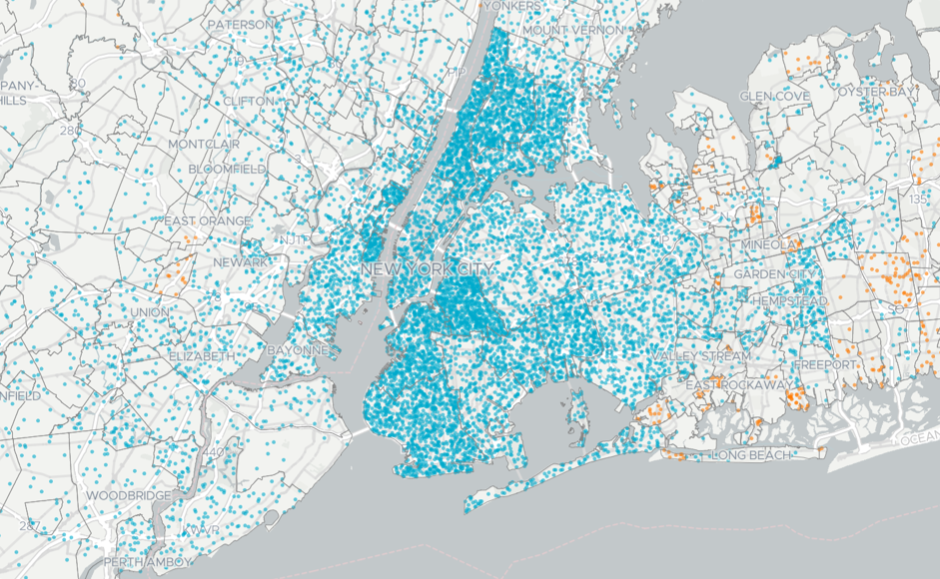Prime working age adults are increasingly clustering in the center of the nation’s largest metro area
City Observatory has long been following the movement of people and jobs back to cities. Our inaugural study on the Young and Restless charted the growing propensity of well-educated young workers to live in close-in urban neighborhoods. Our follow up work on City Center Jobs plotted a remarkable resurgence in job growth in city centers compared to the urban periphery.
A new report from New York City’s Office of Planning sheds further light on how this trend is playing out in the nation’s largest metropolitan area. It has a couple of very salient maps. The first shows the population growth of the greater New York region since 2010. As widely reported, the most urban boroughs Brooklyn, the Bronx and Manhattan, have been powering regional population growth, with the five boroughs accounting for 60 percent of the region’s population growth. As this dot density map shows, population growth (the blue dots) is heavily concentrated in the center of the region. Population growth in the suburbs is considerably more sparse, and in some places (the orange dots) population is actually declining.

As the report concludes: “In recent years, population growth has shifted toward the region’s center. Recent growth patterns suggest that more people are moved to and stayed in our region, with a focus on the urban core and in areas well-connected to rail transit.” Overall, suburbs have grown more slowly, and in some areas, suburban population has declined. As we’ve pointed out before, far from “hollowing out” the New York region is growing, especially in its center.
The working age population is even more centralized
While much of the media attention gets devoted to overall population totals, we like to zero in on the demographic composition of city population changes. What’s been driving the surge in city population? The answer, according to the new NYC planning report, is working age adults. The urban/suburban divide is even more stark for prime age workers (again, blue dots represent an increase and orange dots a decrease). The pattern of change since 2000 shows that with the notable exception of Manhattan’s East side, nearly all of the labor force gains have been concentrated in Manhattan and the close-in portions of the Bronx, Brooklyn and New Jersey. There’s a consistent pattern of labor force decline in the more suburban parts of the region (Nassau and Suffolk Counties on Long Island, and the New Jersey suburbs).

This growth was economically significant: the five boroughs of New York City expanded their prime-age labor force much more rapidly than the nation as a whole. As the report notes, “The rate of NYC’s prime-age labor force growth (gain of 17 %) was nearly three times higher than the U.S. average (gain of 6%), which increased more slowly as the baby-boomer cohort grew older and was replaced by younger, smaller population cohorts.”
What these data show in New York is the growing centralization of economic activity. More people are moving to the center, and especially more working age adults. Several forces are powering these trends: the growth of the knowledge economy, which thrives on the density of smart people, the growing desire for urban living and amenities, and a generational shift in attitudes about the relative attractiveness of cities and suburbs. These forces are in important respects mutually reinforcing: firms are increasingly growing the in center of the region (in part to tap the labor force) and the labor force is growing more in the center (because of more concentrated job growth).
This shift to the center is closely connected to the region’s most pressing challenges. With more jobs and workers in the center of the region, its little surprise that there’s been a sharp increase in ridership on city subways. Likewise, the growing demand for urban living, in the face of a slowly growing housing stock is putting pressure on rents. In New York, as elsewhere, it’s yet more evidence that we’re experiencing a “shortage of cities.”

